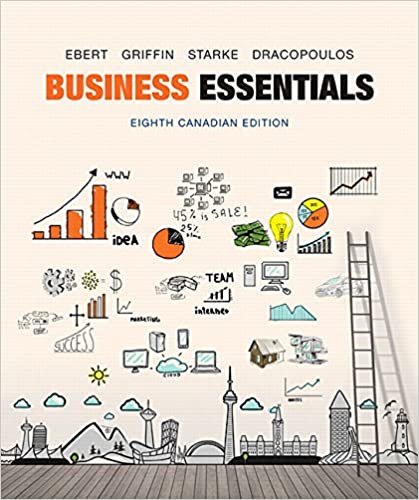Business Essentials 8th Canadian Edition By Ronald J. Ebert – Test Bank
Chapter 1 Understanding the Canadian Business System
1.1 Multiple-Choice Questions
1) Profit is
A) what remains after business expenses are subtracted from business revenues.
B) what remains after dividends have been paid to stockholders.
C) equal to total revenue minus cash expenses.
D) what remains after income taxes have been paid.
E) double the amount the company pays in.
Answer: A
Diff: 1 Type: MC Page Ref: 5
Skill: Knowledge
Objective: 1.1
2) What are profits?
A) Total money taken in by a corporation
B) Increases in income from year to year
C) Increases in a corporation’s stock price
D) Revenue generated by goods and services
E) Difference between revenues and expenses
Answer: E
Diff: 1 Type: MC Page Ref: 5
Skill: Knowledge
Objective: 1.1
3) Profit is
A) the market value of shares of stock in a company.
B) the level of expenses divided by the firm’s assets.
C) what remains after business expenses are subtracted from business revenues.
D) gross revenue minus taxes a company pays.
E) gross sales minus taxes a company pays.
Answer: C
Diff: 1 Type: MC Page Ref: 5
Skill: Knowledge
Objective: 1.1
4) This week, Abe’s Muffler Shop had sales of $4000, employees were paid $1000, the cost of goods was $1500, and rent was $500. Profit for the week was
A) $3000.
B) $1000.
C) $4000.
D) $2500.
E) $500.
Answer: B
Diff: 2 Type: MC Page Ref: 5
Skill: Application
Objective: 1.1
5) How are provincial universities in Canada different from business firms?
A) They do not seek to make a profit.
B) They deal with people, not things.
C) Their organizational boundaries exclude business firms.
D) They do not produce goods or services.
E) They are more important to society than business firms.
Answer: A
Diff: 2 Type: MC Page Ref: 5
Skill: Comprehension
Objective: 1.1
6) Forbes magazine ranked 134 countries in terms of how attractive they were to do business in. Where did Canada rank?
A) First
B) Second
C) Fifth
D) Twenty-fifth
E) Eighty-seventh
Answer: A
Diff: 2 Type: MC Page Ref: 5
Skill: Knowledge
Objective: 1.1
7) Examples of businesses include all of the following except
A) local supermarkets.
B) one-person businesses, like barbershops.
C) non-profit organizations.
D) large corporations like Canadian Pacific or Alcan Aluminum.
E) farms.
Answer: C
Diff: 2 Type: MC Page Ref: 5
Skill: Comprehension
Objective: 1.1
8) ________ produce most of the goods and services consumed in Canada.
A) Businesses
B) Labour unions
C) Non-profit organizations
D) Canadian provincial governments
E) Charities
Answer: A
Diff: 1 Type: MC Page Ref: 5
Skill: Comprehension
Objective: 1.1
9) Not-for-profit organizations
A) are content with small profits, whereas business firms want large profits.
B) are more important than business firms in the Canadian economy.
C) use the funds from government grants or from the sale of goods or services to provide service to the public.
D) sell only services, not goods.
E) are not allowed to operate in the manufacturing sector.
Answer: C
Diff: 2 Type: MC Page Ref: 5
Skill: Comprehension
Objective: 1.1
10) If two people exchange an apple, they each still have just one apple, but if they exchange ideas, they now each have two ideas. This is an illustration of
A) the importance of natural resources.
B) the principle of specialization of labour.
C) the difference between information and all the other factors of production.
D) the importance of profit in market economies.
E) the importance of government regulation.
Answer: C
Diff: 2 Type: MC Page Ref: 5
Skill: Comprehension
Objective: 1.2
11) The key difference between economic systems is the different ways in which they manage
A) the factors of production.
B) the transportation of goods within their borders.
C) government rules and regulations.
D) the payment of workers.
E) the degree of competition that is allowed in various domestic industries.
Answer: A
Diff: 2 Type: MC Page Ref: 5
Skill: Knowledge
Objective: 1.2
12) An economic system is
A) an agreement between countries that deals with free trade.
B) the way in which a nation allocates its resources among its citizens.
C) a government decree that requires certain goods and services to be provided.
D) a long standing agreement between citizens and governments on how an economy is run.
E) a large government department that oversees how the economy is running.
Answer: B
Diff: 2 Type: MC Page Ref: 5
Skill: Knowledge
Objective: 1.2
13) What does a planned economy rely on a centralized government to do?
A) Support free enterprise in every way possible
B) Allocate all or most factors of production
C) Encourage citizens to buy shares of stock in small companies
D) Keep its control activities to a minimum
E) Direct workers to start their own small businesses
Answer: B
Diff: 2 Type: MC Page Ref: 5
Skill: Knowledge
Objective: 1.2
14) In a command economy, the central government
A) supports free enterprise in every way possible.
B) decides on the allocation of all or most factors of production.
C) encourages citizens to buy shares of stock in small companies rather than large ones.
D) keeps its control activities to a minimum so it doesn’t interfere with business efficiency.
E) creates shortages on purpose in order to motivate businesses to be more efficient.
Answer: B
Diff: 2 Type: MC Page Ref: 5
Skill: Knowledge
Objective: 1.2
15) In terms of factors of production, Imperial Oil’s crude oil reserves are an example of ________, while market forecasts are an example of ________.
A) labour; entrepreneurs
B) information; labour
C) capital; information
D) natural resources; information
E) information; natural resources
Answer: D
Diff: 2 Type: MC Page Ref: 5
Skill: Comprehension
Objective: 1.2









Reviews
There are no reviews yet.